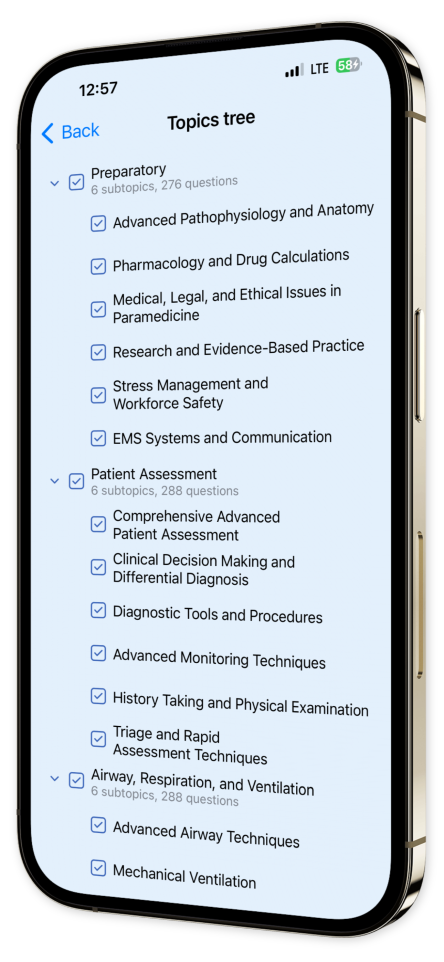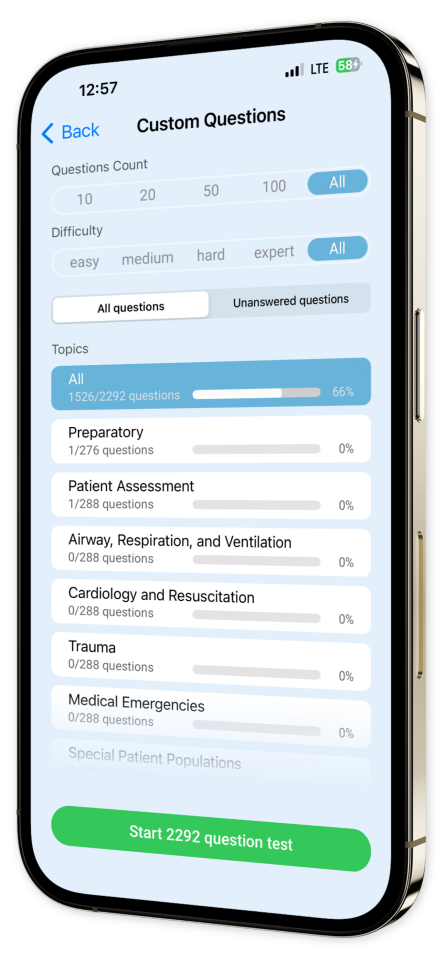

Paramedic Mastery iOS and Android App
Achieve Paramedic Certification Excellence with Paramedic Mastery!
Prepare to reach the pinnacle of emergency medical care with Paramedic Mastery — the ultimate app for highly skilled professionals committed to advancing their paramedic expertise. Designed for those aiming to excel in their Paramedic certification, our app provides a comprehensive resource to master the complex medical knowledge and practical skills required in this critical field.
Explore an extensive array of challenging, exam-focused questions and in-depth explanations that delve into advanced medical procedures, critical care techniques, and emergency protocols. With sophisticated performance analytics and tailored feedback, you can refine your understanding, focus on areas needing improvement, and build the confidence required to excel on exam day.
Join the elite group of paramedics who have achieved certification success and elevated their careers with Paramedic Mastery. Enhance your proficiency, sharpen your decision-making, and become a leader in pre-hospital emergency care. Download now and take the next step toward achieving mastery as a certified paramedic!
Content Overview
Explore a variety of topics covered in the app.
Example questions
Let's look at some sample questions
How can paramedics reduce the risk of injury on the job?
By ignoring safety protocolsBy rushing to complete tasksBy using proper lifting techniquesBy working longer shifts
Paramedics can reduce the risk of injury on the job by using proper lifting techniques. This can help prevent injuries such as sprains, strains, and back injuries.
What is the normal range for adult heart rate?
60-100 beats per minute30-60 beats per minute100-120 beats per minute50-80 beats per minute
The normal range for an adult's heart rate is 60 to 100 beats per minute. Rates outside this range may indicate a medical condition that needs attention.
What is the primary purpose of the secondary survey in physical examination?
To identify life-threatening conditionsTo obtain a detailed historyTo perform a focused assessment based on the chief complaintTo reassess interventions
The secondary survey is a focused assessment based on the chief complaint. It involves a systematic head-to-toe examination and further history taking.
Which of the following is NOT a contraindication for oropharyngeal airway insertion?
Conscious patientIntact gag reflexSevere facial traumaNone of the above
None of the options are contraindications for oropharyngeal airway insertion. It can be used in conscious patients, those with an intact gag reflex, and those with severe facial trauma, although care must be taken in these situations.
Which technique is most commonly used for endotracheal intubation?
Direct laryngoscopyVideo laryngoscopyFiberoptic bronchoscopyTransnasal intubation
Direct laryngoscopy is the most commonly used technique for endotracheal intubation.
Which body system is most susceptible to blast injuries?
Skeletal systemRespiratory systemNervous systemDigestive system
The respiratory system is most susceptible to blast injuries due to the rapid change in atmospheric pressure that can occur during an explosion.
What is the primary treatment for a patient with hypoglycemia?
Insulin administrationOral glucose administrationIV fluidsOxygen therapy
The primary treatment for hypoglycemia is oral glucose administration to quickly raise the patient's blood sugar levels.
Which medication is first-line treatment for pediatric ventricular fibrillation?
EpinephrineAmiodaroneAtropineAdenosine
Amiodarone is the first-line treatment for pediatric ventricular fibrillation. It's used to restore normal heart rhythm.
What is the recommended method for securing an airway in a bariatric patient?
Oral intubationNasal intubationTracheostomyVideo laryngoscopy
Video laryngoscopy is recommended for securing an airway in a bariatric patient due to the difficulty of direct laryngoscopy in these patients.
What is the first step a paramedic should take when approaching a potentially violent situation?
Call for police backupApproach the patient directlyUse physical forceAttempt to calm the situation verbally
The first step a paramedic should take when approaching a potentially violent situation is to call for police backup. This ensures the safety of the paramedic and other individuals at the scene.









